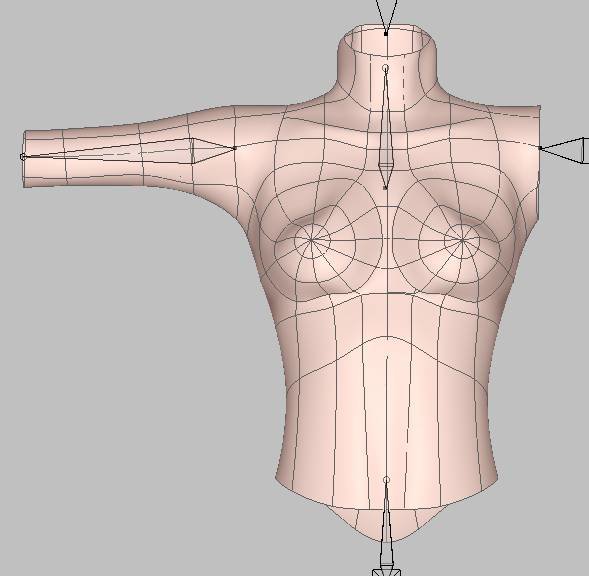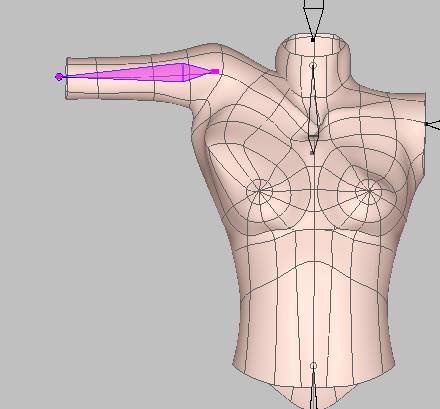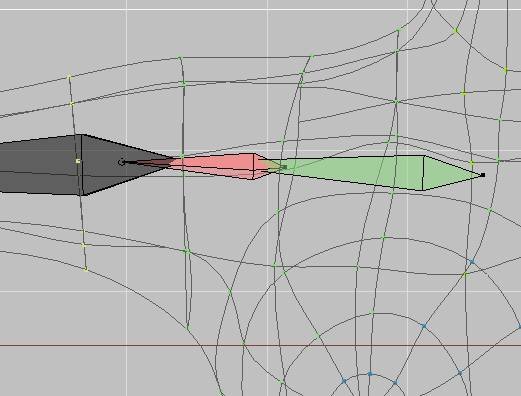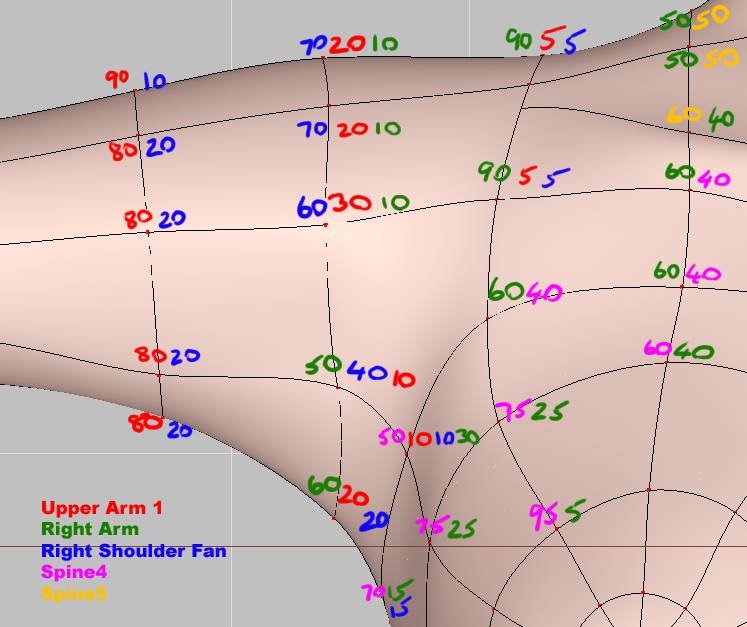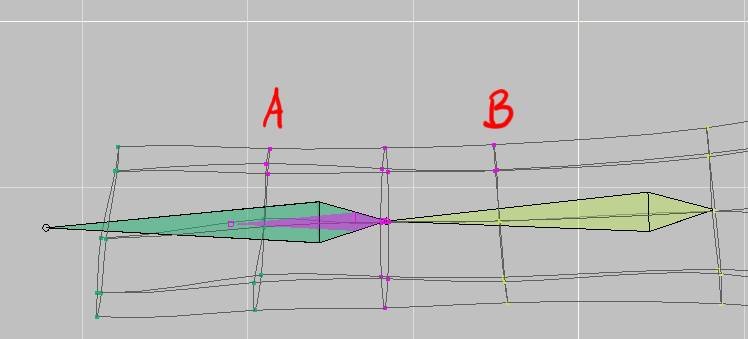-
Posts
1,248 -
Joined
-
Last visited
Content Type
Profiles
Forums
Events
Everything posted by Caroline
-
I've recently learned Shift 1 and Shift 6 (not num pad keys), which I do quite regularly. Shift 1 puts the spiky things on patches so you can see the direction, and Shift 6 makes patches facing the wrong way go transparent. Use the patch tool to select a transparent patch, and press F. Doesn't take too long.
-
Are the leg bones hidden? I just had that problem where I could not select a bone because it was hidden in the PWS under the model's bones. Also, depending on the hierarchy, I don't think you can select bones where you might get a circular reference. Do you have a screen shot of the hierarchy and the bone you are trying to constrain to the other bone? (I'm a bit hazy on that one though.) My question to anyone who has used TSM advanced fingers - did your thumb constraints get created on the Rigger? Mine didn't.
-
And Cooper - have you tried this tutorial? (11.5 in TaoA:M manual) http://www.colins-loft.net/CoopFace.html I've been trying to analyse why your face looks so flat. I think it is partly that the eyes are very big, and the nose is very small. Are you going for realistic or stylized? Also, if you look at the side of your model's face to the left and right of the mouth, there is no curve. It's like the mouth continues flat and does a 90 degree turn to go to the back of the head. You can't tell from a mirror, but feel your own mouth, and you will note that there is no flat bit on either side. None. It is one curve to the back. And the mouth itself is not flat, from the corner to the center of the mouth, it is a curve forward. (OMG maybe I am a freak, and nobody else looks like that ) It is certainly better than it was before, keep trying.
-
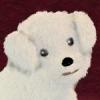
WIP... she is a beautiful Thai moview star.
Caroline replied to StormedFX's topic in Work In Progress / Sweatbox
I did not realise you had started on it until I clicked the picture and it resized big. That's a HUGE number of splines, especially coming out of the bottom left of the nostril. Still, I guess it's easier to take them out than put them in She's got a very interesting asymmetry - she looks like Sandra Bullock on her left. -
Thanks, MMZ Jason - When I've finished rigging, I'll have to do a test to see how well she animates. I would think some smartskin would be necessary, although she will be quite heavily weighted. The way I see the difference between Smartskin and cp weighting, is that Smartskin watches the rotation of one particular bone and interpolates between the rotations, whereas weighting is more 3-dimensional, and follows all bones that are weighted. Anybody got a better differentiation? Thanks for the link, excellent overview of my first few posts - I will include it in my first post. I got overview movies on my CD, but I don't know if they are part of the freeware distribution.
-
Would that be better? Is there anything wrong with where I have put mine? I found that if I moved the fan closer to the biceps, the rotation of the arm at the shoulder looked wrong. Perhaps it's this mesh.
-
That's right - Mark says that he doesn't use shoulder fans at all, but I could not get the weighting right without it. Each CP when it is weighted will follow the bone that much percentage. So if it is not weighted at all, then the CP will follow the bone assigned to it 100%. On a shoulder, you want it 50% with the arm, 50% with the shoulder. But when the CPs are weighted like that, then they will at certain rotations sink too far into the mesh. Weighting them to a fan bone that does not sink as far, keeps the CPs from sinking. At least that's the way I'm understanding it
-
Stage 6 - Shoulder Joint This is the hardest joint so far. I have created a special model of just the shoulder area. I have autoassigned bones, and done a full TSM rig without any fan bones or weighting. GalaDM_RigStage006Shoulder.zip I would not suggest this 'in the real world', but I have not done a full shoulder before, and I wanted to make sure that the full TSM movements correspond the way I think they do. You can see that as soon as we turn the constraints on (remember that TSM constraints have to be turned ON in the Pose window), the chest become deformed. This will take some working out One of the complications of the shoulder is that it has movement around, plus the arm rotation. First movie of arm rotation with no fans and no cp weights riganim12.mov Click on one of the shoulder's cps. Even though the model has been fully rigged with the TSM rigger, and new control bones created, the geometry cps that we assigned earlier stay as they were. Clicking on one of the cps selects that geometry bone. Click on the eye in the PWS to show the geometry bone. Add a fan bone and call it "Right Shoulder Fan" Edit the Setup relationship, and create a constraint for the fan bone - make the fan bones children of "1right arm", and orient like the "right upper arm1" 50% These are the actions I used for weighting: ShoulderRotation.zip ShoulderMovement.zip Using the shoulder rotation action, weight the CPs. This is how I weighted the front (actually I may have fine-tuned a little bit more after this picture - even a 2% weighting can have some effect on skin that looks too static during the movement): Then run the shoulder movement action, and correct the CP weighting. To do my weighting, I moved the timeline slider to a time where the CP looked in a bad position. I corrected it in the action, clicking Apply until I could see the CP in the right place, then OK, and I could immediately see the results by dragging the timeline slider. Every so often, you will get a duplicate weight with a 0%. Delete this weight when you see it, or A:M will 'repair' it for you. Always click Apply before clicking OK, because occasionally A:M will override what you have done, and you may get weighting you don't expect. More on the theory of weighting. In this picture I am fine-tuning the weighting in the action window. You can see the selected CP is out of centre, because the action has pulled it and the CP on the right towards the right. Two choices here. I can weight the CP on the left of it slightly, so that it is pulled too, or I can weight the selected CP more to the left. I am going for the last one, and adding more to the spine (on the left) percentage, which means that the centre CP will not move so far to the right. Remember that when you decal the surface, where the patches are stretched, the decal will also be stretched. Just to illustrate this point: riganim015.mov You can see that the stretching on the back is OK, but on the top of the shoulder, the CPs do not move towards the arm enough, and the decal is very stretched. 'Finished' shoulder (I don't believe weighting is ever 'finished' - when coming to animate the whole body, some refinements will probably be needed). GalaDM_RigStage006AfterWeighting.zip Resulting movies - they don't differ too much from my previous four fan weighting. Maybe a little less subtle movement. riganim016a.mov riganim016b.mov I will now transfer these weights to my main GalaDM model - anybody know a quick way of doing that?
-
So happy you are there, Jason - it's a long haul . For me there are no downsides, except time and ease of picking the right fan at the right time, but I did get a pretty good version with one fan, which is more efficient. I'll be posting that in a few hours when I've documented. it.
-
Gerry, I should have put this here, not in the other thread: Have you turned your constraints on in the Pose window? TSM Constraints has to be turned ON, and also your own pose where you created your own constraints has to be ON. You can set them to be permanently ON in User Properties under the model's properties.
-
Are you sure you turned your poses ON in the choreography, Gerry? TSM Constraints has to be turned ON, and also your own pose where you created your own constraints has to be ON. You can set them to be permanently ON in User Properties under the model's properties. I have been weighting my shoulder joint after the final TSM Rigger, and that seems to be working well, so you can fine tune it after TSM Rigger. I have been doing that to make sure that the actual TSM visible bones are working on my extra bones in the way that I think they ought to.
-
Aargh. I read too much stuff. Everybody else uses a gazillion fans. I've got it down to one - it does not hold the mesh out quite as well as four, but this is supposed to be an uncomplicated model. No fans made the shoulder sink in too far. So, Mark, is it your work process to put the usual bones in, then weight, review, weight, review, weight, review? I have been doing each CP individually around the shoulder - is that what you would do? (I find it quite restful and satisfying, actually.) Or do you just ---know---?
-
I tend to do it this way (but not so organised and more wonky): http://www.nvcc.edu/home/nvportg/Art%20279...ore_details.htm And it does show it in TaoA:M Exercise 11.5, which is taken from here: http://www.colins-loft.net/CoopFace.html
-
I'd like to make sure I'm on the right track before I document. I'd like a nice simple shoulder, and I've been analysing heaps of shoulder rigs. This is what I have come up with for the fan bones (4 of them): Front: Top: And I don't know if you can tell from these front on movies - the rotation is circular - this is after weighting: Arm Rotation without shoulder: riganim014a.mov Shoulder Rotation without arm: riganim014b.mov It looks OK to me - but have I got the fans in completely the wrong place?
-
Wait till you see the mess I'm making of the shoulder That's going to take a couple of days.....
-
Stage 5 - Pivot Joints Pivot Joints are wrist, ankle and head. Even though I want to keep Gala as low spline as I can, I feel that the 3 spline action with fan bone is the most elegant, so I have added an extra spline for her wrist. Tip - Brilliant Shortcut Key. I thought that the wrist was a bit elongated, so wanted to bring in the hand closer to the arm. This involves moving both cps and bones. In Bones mode, click on the Hand bone. Press the "N" key (Translate). Hold the Ctrl key down, and move the hand bone. This will move the hand bone, all bones under the hand bone, AND the CPs. 1. Click "1 right lowerarm2" and add a fan bone pointing towards the hand, and call it Right Wrist Fan. 2. Enter the values exactly as the bone on top of the fan bone, ie in this case the wrist fan bone's Start values and Rotate values will be the same as the hand bone. 3. Weight: Spline A - 75% hand, 25% fan. Spline B - 50% fan, 25% hand, 25% forearm Spline C - 75% forearm, 25%fan. Remember that if you assign one of the points in bones mode to each bone, the bones will appear in the list when you edit the CP weights in modelling mode. If you do not assign the bone to a cp point, you have to hunt it down in the drop down list. 4. Edit your Setup Relationship (right click it and Edit), and create an Orient Like Constraint, orienting the Right Wrist Fan 50% to the Right Hand. 5. Check the wrist movement in an action, remembering to turn the Setup Pose on riganim11.mov GalaDM_RigStage005.zip
-
Fixed for next section. Thank you, Mark (and David and Robert) - I (and hopefully those who come hereafter) much appreciate it. It is fascinating to get an insight into a real rigger's mind. It's a totally different art form than modelling & texturing & lighting.
-
5 point patches won't work with hooks - are they hooks in the patch? You could take the spline a little further and hook it lower down.
-
Nope, smartskin needed more splines to make the squash right. The middle section needed one spline to go with the end joint, and a second to go with the middle joint, and it only has one to do service for both. So I'll save the smartskin tute for a bit later. Going with B. This is for those who eyes have not yet glazed over - fixed some splineage issues in the right hand, and completed fan/constraints/weighting in right fingers and thumb.. GalaDM_RigStage004e.zip Still to be done here - knee and centre of hand / base of fingers. Moving on to Pivot joints - wrist, ankles, thumb base and maybe head rotation.
-
[smacks self on back of head] - you are right, Mark - the movie B is the one with the splines further apart. I'll edit that post to put them right. And my saved models are all up the creek too. My next post will be, as you suggested, to put it back to no splines, and just fan with smartskin, because that may be the way to go on this one. I'll have a look, and post the result, then choose between that and B. [Thinks...I wonder how much processing overhead each one has.]
-
I tried it, and could not get it to work in v15 It did work in v13. You could try baking the material into a decal and using the decal to colour the hair.
-
Aha. This gets interesting. I added splines each side of the joint. I thought they should be fairly close, but the joint got squished. riganim010c.mov So I moved the splines away from the joint, weighted splines A & B 90/10 main/fan - looked fine. riganim010b.mov Then read your post, and moved splines back in, and weighted the bottom cp of Splines A and B either side of each joint 50/50 main bone/fan bone - because of the contraction of splines A & B, the joint does not get squished. riganim010a.mov A multitude of possibilities, depending on how you want your fingers to be modelled. (Gala has extra long unreal fingers.) Tips on adding splines: Add the splines in, create an action for the movement you want - here's the action I used: FingerAction.zip Move the splines in modelling mode. Check the spline movement in the action in modelling mode (so the bones don't hide your view). Check it in front view, and hide the fingers as you complete them. Something it took me a long time to find - It is much easier to switch windows using the Workbook mode. View Menu > Tick Workbook. You now have tabs at the bottom of the screen to change windows. Also, Window Menu > Tile Vertically allows you to have two windows next to each other.
-
Thanks for looking out, guys - yes, that weighting does look better. Although I'm not certain about the weighting the elbow spline - when I overlaid in Photoshop, it makes the elbow ring contract (albeit with 5% each way, not very much) - is that a good thing? riganim006.mov GalaDM_RigStage004c.zip Using the same principles, we can now rig the right knee, and the end two joints of the fingers. For the fingers: This movie is weighting the central splines 50% between the two bones (bad) riganim007.mov This movie is fan bone only (bad) riganim008.mov Sadly, this is the only one I could live with, which has the extra splines stitched in - you were right about that, too, Mark. This movie is fan bones and weighting those A/B splines (90/10), almost like the elbow - I looked at less weighting in the top of the finger, like the elbow, but in this case I could not see any difference. riganim009.mov Remember to create the constraints for the finger fan bones - right click your previous Relationship (I called mine Setup), choose Edit Relationship. Short hiatus while I stitch splines into all those fingers - I noticed a comment in another thread about rigging before texturing. I guess this is why.
-
Thank you, Robert - I went for a while - so I will bear your hacks in mind, but I think I will investigate them after we have discovered what TSM brings to us without any hacking. I am sure that these will make it all faster in the end.
-
Learn something everyday, Holmes - or it seems that I am learning 10 new things before breakfast these days Argh - you're so right, Mark. So would I add fan bones even in the fingers? Rigging Gala - Stage 4c - Fan Bones and CP Weighting in Hinge Joints. 1. Revert to your Fan Bone model from stage 4 - Updated Fan Bone Creation. Or load this model - GalaDM_RigStage004a.zip - this has a group to hide all but the elbow, and all bones except the ones involved are hidden. 2. Select the fan bone, and assign a couple of cps to splines A & B in the picture. (You will see the reason for this in a moment) 3. Create a new action for the model. CP Weighting can be done in modelling mode, but if you do it in an action, the result will be the same, and you won't accidentally move the model's cps or bones. 4. In Muscle Mode (F7), highlight spline A. Right click it and choose Edit CP Weights. 5. Click each bone in section A, and change the weight in circled section B. 6. Change "1 right lowerarm1" to 80% and "Right Elbow Fan" to 20%. Click Done. The reason for assigning a couple of CPs in step 2, was so that the bone would show up automatically in the list, and you would not have to search for it in the Bone dropdown. 7. Repeat for Spline B, and change "1 right upperarm2" to 80% and "Right Elbow Fan" to 20%. Click Done. 8. I moved the elbow joint towards the back of the arm, because that is where the natural rotation of the elbow is, and it looks better In the animation. (It may stuff up my mirrored bones though). riganim005.mov Tip: For a great video showing CP weighting (and other bone stuff): David Simmons - Rigging a Face Experts - are we at elbow perfection yet ?









